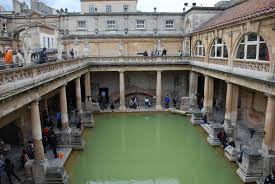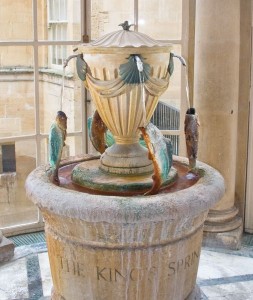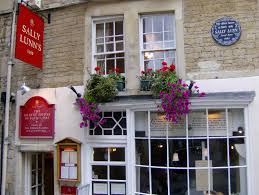I’m taking a little blogging break for a couple of weeks, but we have an excellent guest blogger today, talking about the gorgeous city of Bath! Keira Soleore is a a freelance book editor, a content editor for a travel start-up, and a medieval & Regency romance aspiring writer. Visit her at www.keirasoleore.org….
Anyone who has visited Bath, England comes away with loving memories of a city rich in history and beauty. As Samuel Johnson wrote: “Let me counsel you not to waste your health in unprofitable sorrow, but go to Bath and endeavour to prolong your life.” For seventeen centuries, the City of Bath has hosted visitors from all walks of life believing exactly that. There’s this fan of Bath, H.V. Morton, who in 1927 wrote: “I like Bath. It has quality. I like Bath buns, Bath Olivers, Bath chaps, Bath brick, Bath stone (which to my London eyes is the beautiful sister of Portland stone), and watching the Bath chairs dash past.” Honestly, do you see any denizen of a Bath chair (AKA wheelchair) wanting to dash about the steep hills of the city?”
This gem in the Avon river valley lies over a volcano that sends up hot mineral water to the surface. King Bladud, who reigned in England 900 years before Christ is credited with the discovery of these springs. The first shrine at the site of the hot springs was built by Celts and was dedicated to the goddess Sulis, whom the Romans later identified with Minerva. Agricola arrived in Bath in the Roman year of 861. He called the city Aquae Sulis and constructed the temple to Minerva in 70 CE. He brought with him a taste for the Roman life, including public bathing, wearing of togas, traveling on well-constructed roads, and building temples and government buildings.
The waters of Bath were a natural draw for the elderly and the sick in the belief that bathing in and drinking of these waters cured the sufferers of all ailments, real and imagined. The Roman Baths that still stand today were built over the course of 300 years. King Bladud’s statue, which stands proudly in these baths, is saluted to in the whimsical words of Richard Brinsley Sheridan “Bladud assures me: Tho’ in his youth, about three thousand years ago, he was reckoned a man of Gallantry, yet he now never offers to take the least advantage of any lady bathing here.”
 While public bathing continued to be the mainstay of life in Bath, many people disapproved of the practice. John Wood the Elder was much preoccupied with the licentious behavior in the baths: “Modesty was entirely shut out of them; People of both Sexes bathing by Day and Night naked.” Can you sense the outrage dripping in each syllable there? Many archdeacons and rectors over the years tried to school people in modesty;drawers for men, smocks for women, and no intermingling of the sexes. But people continued to court excommunication in order strip naked and enjoy bathing in their natural glory.
While public bathing continued to be the mainstay of life in Bath, many people disapproved of the practice. John Wood the Elder was much preoccupied with the licentious behavior in the baths: “Modesty was entirely shut out of them; People of both Sexes bathing by Day and Night naked.” Can you sense the outrage dripping in each syllable there? Many archdeacons and rectors over the years tried to school people in modesty;drawers for men, smocks for women, and no intermingling of the sexes. But people continued to court excommunication in order strip naked and enjoy bathing in their natural glory.
 While John Wood the Elder was airing his views, John Wood the Younger was involved in a different project. He designed and built the Royal Crescent, a row of 30 terraced houses laid out in a sweeping crescent. This greatest example of Georgian architecture was built between 1767 and 1774 and is among the most enduring landmarks of Bath. Be sure to visit Number One Royal Crescent to see a typical townhouse in Georgian times. The others crescents to visit are the Lansdown Crescent and The Circus.
While John Wood the Elder was airing his views, John Wood the Younger was involved in a different project. He designed and built the Royal Crescent, a row of 30 terraced houses laid out in a sweeping crescent. This greatest example of Georgian architecture was built between 1767 and 1774 and is among the most enduring landmarks of Bath. Be sure to visit Number One Royal Crescent to see a typical townhouse in Georgian times. The others crescents to visit are the Lansdown Crescent and The Circus.
 The Grand Pump Room, built in 1789 in the Abbey churchyard, was where the Georgian and Regency nobility gathered in the mornings to partake of the sulfurous waters. It was a place to see and be seen, and people dressed carefully for the occasion. Gossiping over glasses of the water was considered the norm as was promenading around the room. Nowadays, you can visit the building for a meal in the reputable restaurant.
The Grand Pump Room, built in 1789 in the Abbey churchyard, was where the Georgian and Regency nobility gathered in the mornings to partake of the sulfurous waters. It was a place to see and be seen, and people dressed carefully for the occasion. Gossiping over glasses of the water was considered the norm as was promenading around the room. Nowadays, you can visit the building for a meal in the reputable restaurant.
The Bath Abbey, AKA The Abbey Church of Saint Peter and Saint Paul, was a former Benedictine monastery, but is now an Anglican parish church. It was founded in the seventh century, rebuilt and/or restored in the 12th, 16th, and 19th centuries. The abbey currently seats 1,200 people and continues to be actively used for religious services, various non-religious ceremonies, and also concerts and lectures. Small eclectic restaurants and shops have sprung up in the lanes surrounding there to cater to the thousands of tourists who throng to the abbey every year.
 One of the oldest houses in Bath and the origin of the famed Bath buns, Sally Lunn’s House is a must visit for its traditional but varied menu. The Sally Lunn Bun is like a teacake made with a yeast dough, cream, eggs, and spice and is very similar to French sweet brioche.
One of the oldest houses in Bath and the origin of the famed Bath buns, Sally Lunn’s House is a must visit for its traditional but varied menu. The Sally Lunn Bun is like a teacake made with a yeast dough, cream, eggs, and spice and is very similar to French sweet brioche.
The 148-foot long 58-foot wide Pulteney Bridge, across River Avon, has been in continuous use since 1774. Sir John Soane’s Museum in London in 2000, I saw Robert Adam’s original drawings for this bridge. To this day, it is only one of four bridges in the world to have shops across its full span on both sides.
And finally, I cannot end an account of Bath without mention of one of its most famous visitors, Jane Austen. In 1897, she wrote in Northanger Abbey, “They arrived at Bath. Catherine was all eager delight;her eyes were here, there, everywhere, as they approached its fine striking environs, and afterwards drove through those streets which conducted them to the hotel. She was come to be happy, and felt happy already. they were soon settled in comfortable lodgings in Pulteney Street.”








